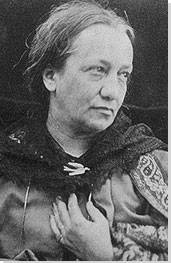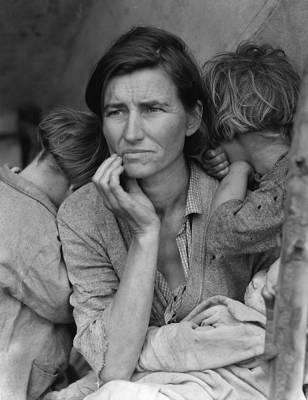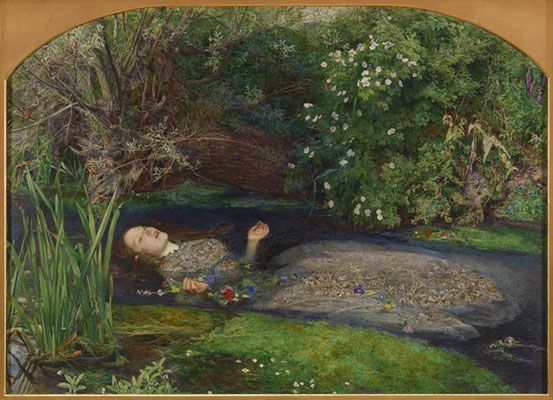Summary of Julia Margaret Cameron
Julia Margaret Cameron was a mighty talent with a mighty heart; her photographs typically have a soft focus whilst her mind and eye have an acute sharpness, the combination of which created a pioneering quality in her work that still endures today. Unlike other early practitioners of the medium, Cameron did not seek technical perfection in her work as a means to "capture" or document reality. She appreciated the scientific processes behind her pursuit but privileged instead the creation of an otherworldly sense of beauty using props, allegory, and slight blurriness. As such, Cameron was intensely aware that she was an 'artist', trying ultimately to expose the emotional internal lives of her sitters. At the time, her experimental style was better received by the Pre-Raphaelite painters than by fellow Victorian photographers. Surrounded by impressive figures, mostly men, Cameron photographed them accordingly with great respect but rejected hierarchy and gave equal attention and importance to passing strangers, children, and nursing mothers.
Accomplishments
- Cameron has become an influential mother-figure for subsequent generations of modern and contemporary photographers with particular interest in making images born out of heightened levels of communication. Following the creation of spaces of trust, consent, and reciprocity it is arguably possible to make more sensitive and revealing portraits, particularly of children. Such was also the endeavor of Diane Arbus, Dorothea Lange, and Sally Mann.
- The notion of showing something of the reflective inner life of the sitter - an interest in the unconscious, the dream, and the imagination as the vehicles through which to explore identity - are the founding principles of Surrealism. Photographers Duane Michals and Francesca Woodman inherit Cameron's use of soft focus, shadow, and the trace as devices to highlight the more magical and ethereal aspects of human existence.
- Cameron upheld a long-term relationship with Sir Henry Cole, the director/curator of the South Kensington Gallery (now the V&A museum), and was even given a studio space in the gallery from 1868 qualifying her as the gallery's first artist in residence. She was at the epicentre of an intellectual and artistic movement (connected to the Pre-Raphaelites) and this was unusual for a British woman at the time.
- Due to her interest in experimenting with special characteristics particular to the medium (for example long exposure and soft focus), Cameron's oeuvre supports key theoretical debates surrounding the relationship between photography and time. Her photographs are now interestingly discussed in the context of the Belgian professor, Thierry de Duve's essay, 'Time Exposure and Snapshot', Walter Benjamin's concept of 'aura', and Roland Barthes' poetic discussions on the "punctum" of an image.
Important Art by Julia Margaret Cameron
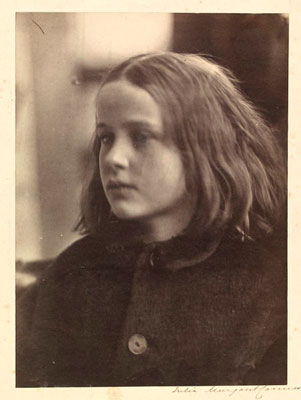
Annie, My First Success
This portrait of Annie Wilhelmina Philpot (1854-1930) was considered by Cameron to be her first photographic achievement, tellingly entitled "Annie, My First Success". Annie's three-quarter length portrait shows her head and shoulders on a slight angle to the left of the photograph. Her dark jacket with a peter-pan collar and round buttons complement her loose hair and pale skin. The little girl typifies Victorian notions of innocence and purity thought to be perfectly embodied within children. It also nods to the idea of Victorian children being considered to be miniature adults - Annie's face is locked in an expression of reserved tranquility. Cameron was so happy with the results of the sitting she remembers she "was in a transport of delight. I ran all over the house to search for gifts for the child."
Cameron sent the print to Annie's father, William Benjamin Philpot (1823-89), a vicar who dabbled in poetry with a note describing that the photograph owed "greatly to the docility and sweetness of the best and fairest little sitter."
Cameron's initial experiments began with little knowledge of the practicalities of photography. It is clear from this work that the initial technical issues she was confronted with were surmounted through trial and error. Cameron wrote, "I longed to arrest all beauty that came before me, and at length the longing has been satisfied. Its difficulty enhanced the value of the pursuit. I began with no knowledge of the art."
With the foundations of her practice established, Cameron began to work in more nuanced, unique, and unconventional ways, but this photograph remains iconic, as it was her first success in both the mastery of photographic technique and in her ongoing aesthetic interest in soft blurriness. Cameronian beauty much like that revered by the Pre-Raphaelites tended to be unsmiling and slightly melancholy, as is first demonstrated by Annie here.
Albumen print from wet collodion glass negative - Victoria and Albert Museum, London
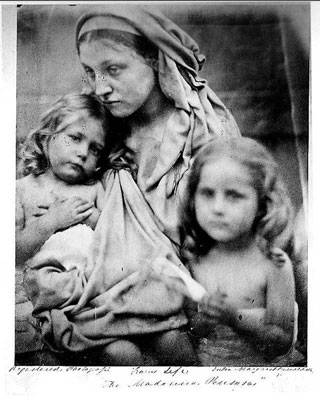
The Madonna Penserosa
The Madonna and Child was a recurring motif for Julia Margaret Cameron and a subject close to her heart as a mother to six children herself. On the one hand then, the images imbue the everyday women with an element of heroism in recognition of the important undertaking of raising children. On the other hand the image makes very clear the artist's knowledge of art history and her belief that the photographs she is making are akin to 'high art'. For of course the composition recalls the great masters like Raphael and Leonardo da Vinci, as well as iconic Byzantine depictions of the same subject. Furthermore, in the artist's particularly sensitive rendering of the child, the photograph interestingly looks forward to modern images in particular those of Dorothea Lange and Sally Mann. There is an uncanny resemblance to Lange's iconic 1936, Migrant Mother photograph (executed mere 70 years later, and thousands of miles away).
Albumen silver print from glass negative - The Met Museum, New York
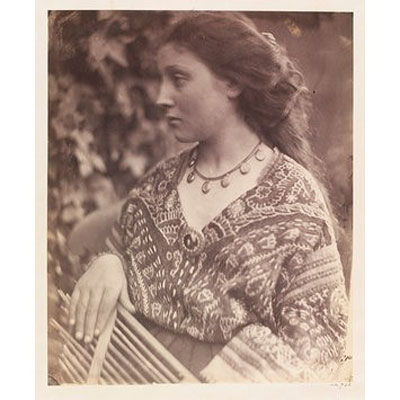
Sappho
This half-length image of Sappho is modelled by Mary Hiller, who often sat for Cameron. She wears a heavily embroidered dress and necklace with antique-looking coins. Her hair is loosely tied and flows gently down her back, most typical of the Pre-Raphaelite style. The background is a blurred wall of vines which softly edge the contours of Sappho's face. Sappho was a Greek poet active in the 6th century BC who famously wrote about women experiencing passionate love with other women. She was considered one of the greatest poets, was honored with numismatics and civic monuments, hailed by Plato as "the tenth Muse" and referred to as the Poetess, equivalent only to Homer's epithet of the Poet.
Sappho gazes to the right, her hand slouched over a Lyre, which symbolizes lyric poetry. In painting and sculpture, poets are often depicted holding a lyre to indicate their status and connection to Apollo. This image was the first of two studies made by Cameron on this subject. Cameron often sought inspiration from painting and sculpture, particularly for her allegorical and narratives photos. While some images were direct interpretations of paintings by Renaissance masters, others were inspired by subject and pictorial effect, but created through new dynamic figurations.
As one of the stand out female artistic and intellectual figures from Antiquity it is an unsurprising subject choice for Cameron, like the Virgin Mary, she is an iconic woman to be honoured and revered. Still however, Cameron was criticized for using the inherently truthful medium of photography to depict imaginary subjects, suggesting that her images be used for only painting studies. Cameron worked hard to have her work be understood for its intrinsic aesthetic worth, and led the way for modernist photographers to justify their medium as a fine art.
Albumen Print from wet collodion - Victoria and Albert Museum, London
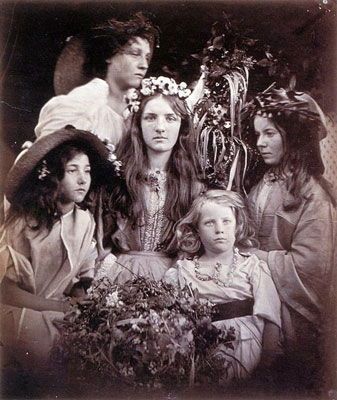
May Day
This photograph bears strong resemblance to the famous Pre-Raphaelite 1965-66 painting, The Beloved (The Bride) by Dante Gabriel Rossetti. Painted only very shortly before this photograph was made, one wonders if perhaps Cameron had had a sneak preview of Rossetti painting having become close to the Pre-Raphaelite Brotherhood.
The central sitter is Cameron's own adopted daughter, Mary Ryan, who plays the title character of Tennyson's poem The May Queen. The photograph shows the English rural custom of crowning a young and beautiful girl as Queen of the May on the first of that month. Cameron would later revisit the theme in two volumes of illustrations to Tennyson's poems. Furthermore, in parallel to Rossetti's painting The Beloved, Ryan did soon afterwards get married to Sir Henry Cotton who had fallen in love having seen Ryan as a model in one of her mother's photographs.
In late 1865, Julia Margaret Cameron began using a larger camera. It held a 15 x 12 inch glass negative, rather than the 12 x 10 inch negative of her first camera, and this is one of the works taken in the larger format. Indeed, Cameron initiated a series of large-scale, close-up heads that fulfilled her photographic vision. She saw these portraits as a rejection of "mere conventional topographic photography in favor of a less precise but more emotionally penetrating form of portraiture". Cameron also continued to make narrative and allegorical tableaux, which were now larger and bolder than her previous efforts.
Victoria and Albert Museum, London
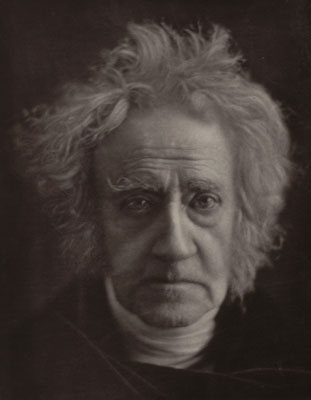
J.F.W Herschel; John Frederick William Herschel
This portrait depicts the scientist and photo-chemist John Herschel. Cameron became acquainted with Herschel in 1835, and their rapport quickly matured into a life-long photographic mentorship. Indeed, Herschel had kept Cameron abreast of new technological developments in the photographic medium even before her foray into the practice. Herschel is shown in a three-quarter view, gazing prophetically into the distance to the middle right of the image. He is swathed in a dark velvet cloak and wears a cap, barely containing his unruly strands of silver hair. The image created is one which highlights Herschel's intellect, and plays on traditional idioms of a "genius-type" figure. His wild hair and the bags under his eyes indicate his tireless efforts in scientific discovery.
Cameron was intensely attracted to the "supreme unselfconsciousness and simplicity of the great men of science", and in turn aimed to capture their affectations of genius. Her talent for capturing the subtle eccentricities and characteristics of her sitters came from a well-recognized interest in the imprecise, the otherworldly. Art historian Mirjam Brusius suggests that "The truth of Cameron's images lies not in their precision but in the allusion they make to the sitters' characters by blurring their physical form." Brusius' statement illuminates a key aspect of Cameron's work - the attention to the medium itself. When confronted with this portrait, the imperfect focus and softly blurred effect, make the viewer think about the ways in which the image might have been taken.
Cameron was not aiming to create a strictly documentarian image of Herschel, rather, she sought to relay an expression of his charisma, intensity, and "genius" qualities. Thus, there was a clear conversion in Cameron's depictions of her cohort from documentary portraits, to images of individuals recorded for aesthetic and emotional value. This was an integral shift in the history of photography, and preceded the art portraits of great individuals by Steichen and Stieglitz.
Albumen print from wet Collodion glass negative - Victoria and Albert Museum, London
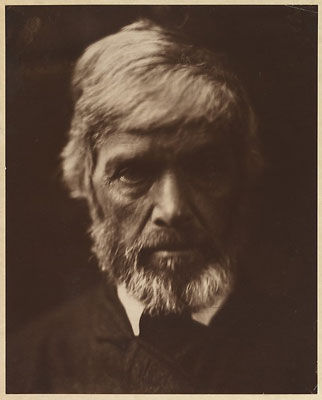
Thomas Carlyle
Cameron's large social circle included not only men of letters, but also diplomats, politicians, astronomers, botanists, scientists, and chemists. One such acquaintance was Thomas Carlyle. Known as the 'Sage of Chelsea', he was one of the great intellectual theorists of the nineteenth century. His essays on history and philosophy influenced Victorian thought and ideals through his praise of the heroic man figure, theories of stable government and advocacy for the suffering of the common person.
It took a long time for Carlyle to be convinced to have his likeness "taken" by Cameron, and when he did, he sat for her only once, resulting in two photographs, one frontal, and one in profile. Carlyle's face is shrouded in a deep shadow, with simultaneous illuminations created from the dramatic lighting. This lighting gives the images an emotional depth, which indicates the Victorian sage's wisdom and intellectual prowess.
It also foils the candour and antagonistic nature of his writing. The Pre-Raphaelite painter William Holman Hunt said Carlyle's face was "despite a shade of rickety joylessness, was one of the noblest I had ever seen". Cameron too was pleased with the resulting image from their sitting, and on some prints inscribed them with the caption reading: "Carlyle [was] like a rough block of Michelangelo's sculpture". Through observing Cameron's work, we can see a continuation of the academic tradition of portrait making, and further discover how she created visual effects in order to enhance the aesthetic impact of her figurative depictions.
These softened, blurred, and whimsical effects were a direct result of her technical process, and were typical of the Pictorialists. Cameron was a true artist, she was also a master technician of the photographic medium burgeoning in the mid 19th -century. Her influence on the Pictorialists such as Heinrich Kühn is evidenced strongly here.
It is also important to note that it wasn't only the great and the good that Cameron photographed. She famously took a picture of Iago, a passing Italian - equally beautiful to Carlyle rendered in deep shadow - and was well known for asking people from the street to model for her.
Carbon Print - The Metropolitan Museum of Art, New York
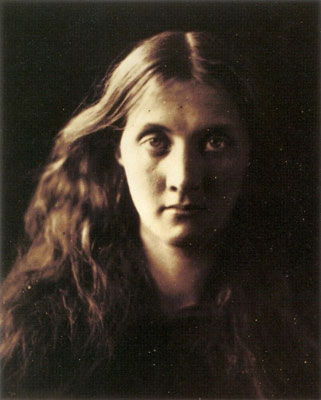
Julia Jackson
The woman depicted in this portrait is Cameron's niece and namesake, Julia Jackson. Jackson's second husband said that "Julia's beauty was conspicuous from her childhood and ... as she grew up she was admired by all who had eyes to see". Indeed she attracted many artists including William Holman Hunt and Thomas Woolner, both of whose proposals she declined. Cameron created over twenty portraits of Julia Jackson, usually capturing her likeness simply, either with loose hair or in noble dress. In doing so, she hoped to portray Julia as an archetype of Victorian purity, beauty, and elegance, as well as a strong, reflective, individual woman.
Here Jackson is sat frontally, starting starkly into the camera, with a frenzied, determined, and powerful look. Cameron's soft focus works effectively to create a spirit-like ethereal portrait removed from the material world and any literary or cultural framework. The minimal background gives little context to the image, and Jackson's intense gaze is highlighted by the lighting. Half of her face is covered in shadow, the other is lit dramatically - creating a sense of conflict within the personality. Her hooded eyelids are defined against the whiteness of her eyes. In creating this portrait, which feels more like a study of light and physiognomy rather than for a presentation of individual status, Cameron appeals to a modernist sensibility.
Julia Jackson was the mother of the artist Vanessa Bell and the legendary author Virginia Woolf, the later of which wrote the first book on her great aunt, Julia Margaret Cameron. In the introduction to Victorian Photographs of Famous Men and Fair Women (1926), a book of portraits by Julia Margaret Cameron published posthumously Woolf wrote that when Cameron was given a camera by her daughter at the age of 48, quickly "[a]ll her sensibility was expressed, and, what was perhaps more to the purpose, controlled in the new born art."
Cameron's photographs of women show them in varying scenarios from domestic settings, tragic scenes from literature, biblical evocations, to simple sparse portrait renderings like this one. In capturing women in different scenarios, Cameron asserts her awareness of the shifting roles of women in Victorian Britain, gifting women with multiplicity rather than type-cast and rigid traditional roles.
Albumen Print - National Museum of Photography, Film & Television, Bradford
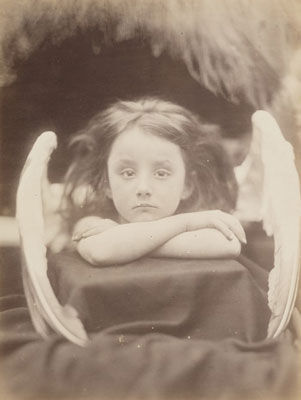
I wait (Rachel Gurney)
Sisters Rachel and Laura Gurney were often used as models by their Aunt Julia. The girls recalled the experience saying that they had fun but never really knew what their Aunt would do next. To Cameron, the ideas were so clear, but to others they seemed quite odd. Indeed the figure of the angel is one to which Cameron returns again and again. One critic writes that the girl's forlorn expression does not quite fit her role as an angel, but quite the contrary is true, for the sad angel has been a motif since Albrecht Dürer made the memorable 1514 etching, Melancolia.
The angel represents the longing to fly but sadness in the knowledge that we are earth bound. There is a wish to unite the heavens and the earth, and the everyday to a more celestial and imaginative life that is commonly felt by the artist personality. Indeed, Francesca Woodman made many photographs titled On Being An Angel, and Virginia Woolf famously wrote about 'Killing the Angel in the House'. Having made a whole host of photographs based on putti from Renaissance and post-Renaissance paintings, Cameron shows the roots of this discussion. Simultaneous to looking at "beauty" she also feels the frustrations of living a life somewhere between the realms of fantasy and reality.
Collection of the J. Paul Getty Museum
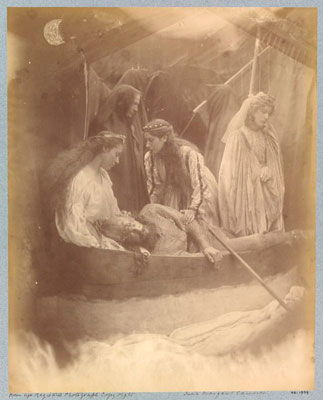
'So like a shatter'd Column lay the King'; The Passing of Arthur
The narrative image, 'So like a shatter'd Column lay the King'; The Passing of Arthur, taken around 1875 accurately encompasses the theatrical, elaborate, and sometimes playful nature of Cameron's work. The Arthurian narrative subject well aligns her with her Pre-Raphaelite contemporaries, who had "leavened the culture and society of the day with an extraordinary passion for beauty." The scene depicts the dead King Arthur being ferried by boat from Camelot accompanied by an assortment of noble ladies and hooded men. The figures were modelled by several of Cameron's friends including Mary Hiller, William Warder as King Arthur, and Mrs.Hardinge. Virginia Woolf noted that Cameron's makeshift dark room in the Isle of Wight had a transformative effect on those around her, and on her artistic production; "The coal house was tuned into a dark room; the fowl-house was tuned into a glass-house. Boatmen were turned into King Arthur; village girls into Queen Guinevere. Tennyson wrapped in rugs; Sir Henry Taylor crowned in tinsel".
Cameron was keen to create a truly theatrical image, as it was to illustrate Alfred Lord Tennyson's Idylls of the King along with 25 other photographs. The slightly off-centre composition creates a vortexical effect, as the eye is drawn to the reposed head of King Arthur. The foreshortened diagonal produces a compressed central pictorial space, which is intensified by the cloudy borders. This effect was likely achieved by manipulating the application of the solutions. The careful control of light sources resulted in the dark upper-left corner and the faded lower-right corner - a contrast that heightens the drama of the scene. The Passing of Arthur in particular shows how a photograph can be elevated from the specificity of the real world and emblematize an emotion, thought, or idea. The intense theatrical nature of distancing the viewer from the scene also lends to an ethereal quality evidenced in a large body of her oeuvre. The "strong spell of individualism" seen in Cameron's work was made possible through the coordination of her technical mastery and aesthetic abilities. While her work appeared accidental it was in fact achieved through her sure sighted vision, scientific, and artistic prowess.
Albumen print from wet collodion glass negative - Victoria and Albert Museum, London
Biography of Julia Margaret Cameron
Childhood
Julia Margaret Cameron was born in 1815 in Calcutta, India. She was the second of seven sisters, born into a wealthy, highly cultured, and well-educated family. Her father James Pattle was a well-respected official working for the East India Company. Her mother, Adeline Pattle was the daughter of French Royalists. As such, Cameron and her sisters spent their youth between India, Versailles, and England. All of the Pattle sisters were known for being vivacious and witty aesthetes, often noticed and commented upon for their unusual beauty and candor.
Education and Early Training
Cameron was educated mostly in France from 1818 to 1834. Her education was well rounded and classical, but not focused on fine art. In 1836 she was recovering from an illness in the Cape of Good Hope. It was there that she encountered two key influences in her personal and artistic development; Sir John Herschel the renowned astronomer and photo chemist, and Charles Hay Cameron, her future husband and a determined liberal reformer whose essay, On the Sublime and Beautiful (1835) had a great impact on her basic aesthetic theories.
Mature Period
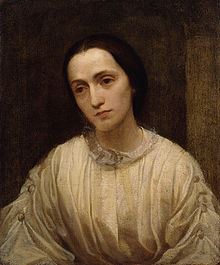
In 1838 Julia Pattle married Charles Cameron in Calcutta, and the couple went on to have six children together (five biological and one adopted). The family conducted vibrant social gatherings with artists and intellectuals and they were keen philanthropists. At this time, Cameron was still not a photographer - she was, however corresponding with Herschel regularly about all the newest advancements in photographic practice. In 1841, her dear and important friend even sent her some "Talbotypes", early examples of photographs by Henry Fox Talbot.
In 1848, the family moved to England, first to Tunbridge Wells in Kent, then to London two years later where Cameron became involved with the Little Holland House group. This was a Salon run by Cameron's sister, Sarah Prinsep, and the setting that introduced Cameron to the aesthetic hub of London, and especially to her life long friend, the painter George Frederic Watts. The second centre of artistic inspiration for Cameron became the Isle of Wight, where the family moved to in 1860 having purchased a home neighbouring that of poet's Alfred Lord Tennyson, who too became Cameron's great friend and artistic colleague.
Dimbola Lodge, the family home on The Isle of Wight was also where Cameron was given her first sliding box camera as a Christmas present from her daughter, Julia, in 1863. Cameron eagerly transformed her chicken coop into a photography studio, and an old coal shed into her darkroom, quickly setting out to fulfill the practices that Herschel had introduced to her nearly twenty years earlier. Her experiments with portraiture, biblical scenes, Arthurian tableaus, and classical painterly subjects were largely carried out on the Isle of Wight with her friends, family, and passers by acting as her models - or as Tennyson humorously called them, due to her determined and unflinching vision, "her victims".
Late Period
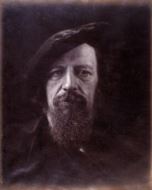
From her "first success" capturing the young Annie in 1864, Cameron worked quickly and diligently preparing photographs with new equipment. She said herself after making the portrait of Annie, "at last came endless success! May I not call them so", revealing her own self-confidence in a long awaited and undoubtedly important developing body of work.
She exhibited widely. Her work was included at the Universal Exposition in Paris of 1867, she had a solo show at the German Gallery in London in 1868, then in the Netherlands in 1869, and again at the Universal Exposition in 1873 receiving a notable award for "Good Taste" in her "artistic studies". The 1870s saw a maturing of the artist's signature soft focus style, more elaborate tableau stage set ups, and rigorous self-reflection. By 1873 Cameron had started to sell her photographs. She was very aware that she was making 'art', and as such acted as a shrewd business woman, registering all of her pictures with a copyright agency.
Cameron also found time to write Annals of My Glass House, a biographical account of her career which she did not entirely complete and which remained unpublished until 1889. Having had so much time to contemplate her career before it actually became fully fledged, when in the midst of her prolific decade of making photographs Cameron assuredly knew that her work was good - she wrote to the director of the South Kensington Museum, Sir Henry Cole that her new prints "should electrify with delight and startle the world. I hope it is no vain imagination." This was the gallery with which she exhibited most frequently and even had a portrait studio where Cameron could take her sitters.
She moved to Ceylon in 1875 to be closer to her sons, and sadly died there the following year having contracted a perilous chill. Prints of her Arthurian legend subjects were exhibited the very same year at the Photographic Society in London, UK demonstrating her full success and influential name in the new world of photography.
The Legacy of Julia Margaret Cameron
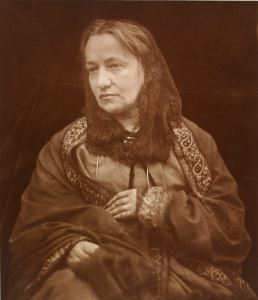
The experimental nature of Cameron's practice caught the attention of the Modernists, and in particular The Bloomsbury Group. Cameron was directly related to Virginia Woolf and Vanessa Bell, because their mother, Julia Jackson (Cameron's famous model) was the daughter of Cameron's sister, Maria. In 1926, the Hogarth Press, which was set up by Woolf and her husband Leonard Woolf, published Julia Margaret Cameron: Victorian Photographs of Famous Men and Fair Women. Virginia Woolf contributed an introductory essay, as did Roger Fry, an influential Bloomsbury Group artist and art critic, and these were followed in the book by a series of plates illustrating Cameron's portraits and costumed tableaux. At the time, the press were publishing other revolutionary material including Woolf's own novels and T. S. Eliot's The Waste Land (1922). In 1939, Woolf proudly gave a signed copy of Victorian Photographs of Famous Men and Fair Women to the successful French photographer Gisèle Freund.
Cameron embraced the ambiguity around her portraits and cultivated it intentionally, making her a forerunner to the Pictorialist photographers, particularly Gertrude Kasiber and Heinrich Kühn, and also an inspiration to Surrealist photography thereafter. The blurry quality of Cameron's images, initially achieved by accident, began an ongoing debate on the nature of the medium of photography, and its ability, or not, to "see" the spiritual aspect of a person. The artist experienced gender-based criticism in her own lifetime when other photographers would say that she simply could not "master" photographic techniques and that this was probably because she was a woman. The point was that Cameron had no intention of mastering anything, she did not want to have authority over others. She said herself, "What is focus and who has the right to say what focus is the legitimate focus? From the first moment I handled my lens with a tender ardour." Her gentle and inclusive approach to creation became an inspiration for subsequent generations of women artists to follow.
Indeed, she has provided huge influence to artists interested in creating a space of reciprocity in order to achieve the best photograph. Cameron was well renowned for asking strangers to model for her and Diane Arbus continued this same tradition. Recognizing that it is necessary for trust to be present in order to photograph children, mothers and babies, and other vulnerable figures, Cameron is a forerunner for sensitive photographers working with these subjects. For artist Imogen Cunningham, there has been and still is "no one better" than Cameron at portraying human likeness through the medium of photography.
Influences and Connections

![Alfred, Lord Tennyson]() Alfred, Lord Tennyson
Alfred, Lord Tennyson- George Frederick Watts
- John Herschel
-
![Dorothea Lange]() Dorothea Lange
Dorothea Lange -
![Francesca Woodman]() Francesca Woodman
Francesca Woodman - Gertrude Käsebier
- Heinrich Kühn
- Oscar Rejlander
-
![Pictorialism]() Pictorialism
Pictorialism -
![Modern Photography]() Modern Photography
Modern Photography - Contemporary Photography
Useful Resources on Julia Margaret Cameron
- Julia Margaret Cameron: A Critical BiographyBy Colin Ford and Julia Margaret Pattle Cameron
- Julia Margaret CameronBy Marta Weiss
- Julia Margaret Cameron: Photographs from the J. Paul Getty MuseumBy Julian Cox
- Victorian Photographs of Famous Men and Fair Women By Julia Margaret CameronBy Virginia Woolf and Roger Fry
- Julia Margaret CameronBy Joanne Lukitsh
- Julia Margaret Cameron: Photographs to Electrify you with Delight and Startle the WorldBy Marta Weiss
